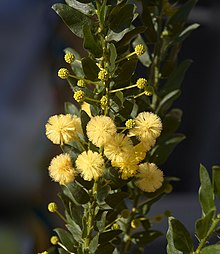Acacia paradoxa: Difference between revisions
No edit summary |
|||
| Line 31: | Line 31: | ||
{{cite journal|last1=Correia|first1=Marta|last2=Castro|first2=Silvia|last3=Ferrero|first3=Victoria|title=Reproductive biology and success of invasive Australian acacias in Portugal|journal=Botanical Journal of the Linnean Society|date=April 2014|volume=174|issue=4|pages=574-588|doi=10.1111/boj.12155|url=http://onlinelibrary.wiley.com/journal/10.1111/(ISSN)1095-8339|accessdate=30 April 2015}} |
{{cite journal|last1=Correia|first1=Marta|last2=Castro|first2=Silvia|last3=Ferrero|first3=Victoria|title=Reproductive biology and success of invasive Australian acacias in Portugal|journal=Botanical Journal of the Linnean Society|date=April 2014|volume=174|issue=4|pages=574-588|doi=10.1111/boj.12155|url=http://onlinelibrary.wiley.com/journal/10.1111/(ISSN)1095-8339|accessdate=30 April 2015}} |
||
{{cite journal|last1=Castro-Díez|first1=P.|last2=Langendoen|first2=T.|last3=Poorter|first3=L.|title=Predicting Acacia invasive success in South Africa on the basis of functional traits, native climatic niche and human use|journal=Biodiversity and conservation|date=1 November 2011|volume=20|issue=12|page=2729-2743|doi=10.1007/s10531-011-0101-5|accessdate=1 May 2015}} |
|||
| ⚫ | |||
| ⚫ | |||
*[http://plants.usda.gov/java/profile?symbol=ACPA8 USDA Plants Profile] |
*[http://plants.usda.gov/java/profile?symbol=ACPA8 USDA Plants Profile] |
||
*[http://www.cdfa.ca.gov/phpps/ipc/weedinfo/acacia.htm EncycloWeedia Profile] |
*[http://www.cdfa.ca.gov/phpps/ipc/weedinfo/acacia.htm EncycloWeedia Profile] |
||
Revision as of 21:01, 1 May 2015
| Acacia paradoxa | |
|---|---|

| |
| Scientific classification | |
| Kingdom: | |
| (unranked): | |
| (unranked): | |
| (unranked): | |
| Order: | |
| Family: | |
| Genus: | |
| Species: | A. paradoxa
|
| Binomial name | |
| Acacia paradoxa | |
| Synonyms | |
|
Acacia armata R.Br. | |
Acacia paradoxa[1] is a plant in the Fabaceae family. Its common names include kangaroo thorn, prickly wattle, hedge wattle and paradox acacia. This is a large shrub up to 3 metres tall and wide. It is dense with foliage; the leaves are actually enlarged petioles known as phyllodes. They are crinkly and the new ones are covered in hairs. The bush is also full of long spines. It flowers in small, bright yellow spherical flower heads and the fruits are brown pods 4 to 7 cm long.
The spiny stipules that grow at the base of the phyllodes deter livestock from feeding on or too close to the plant.
Kangaroo thorn is widely spread across Australia, regenerating from seed after disturbances, such as bush fire. Small birds, including wrens, use this plant as shelter and dwelling, while it is relied upon as a food source for moths, butterflies and other insects, birds also feed on its seeds.
This plant is native to Australia, but has been introduced to other continents. In the United States, kangaroo thorn is a well-known noxious weed in California.[2]
References
- ^ "Acacia paradoxa". Australian Plant Name Index (APNI), IBIS database. Centre for Plant Biodiversity Research, Australian Government, Canberra. Retrieved 2008-04-03.
- ^ "Acacia paradoxa". Plants Profile. United States Department of Agriculture. Retrieved 2 April 2012.
Further Reading
Zenni, R. D.; Wilson, J. R. U.; Le Roux, J. J.; Richardson, D. M. (August 2009). "Evaluating the invasiveness of Acacia paradoxa in South Africa". South African Journal of Botany. 75 (3): 485–496. doi:10.1016/j.sajb.2009.04.001. {{cite journal}}: |access-date= requires |url= (help)
Correia, Marta; Castro, Silvia; Ferrero, Victoria (April 2014). "Reproductive biology and success of invasive Australian acacias in Portugal". Botanical Journal of the Linnean Society. 174 (4): 574–588. doi:10.1111/boj.12155. Retrieved 30 April 2015.
Castro-Díez, P.; Langendoen, T.; Poorter, L. (1 November 2011). "Predicting Acacia invasive success in South Africa on the basis of functional traits, native climatic niche and human use". Biodiversity and conservation. 20 (12): 2729-2743. doi:10.1007/s10531-011-0101-5. {{cite journal}}: |access-date= requires |url= (help)
